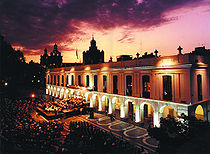
Córdoba Cabildo
Encyclopedia

Cabildo (council)
For a discussion of the contemporary Spanish and Latin American cabildo, see Ayuntamiento.A cabildo or ayuntamiento was a former Spanish, colonial administrative council that governed a municipality. Cabildos were sometimes appointed, sometimes elected, but were considered to be representative of...
(colonial town hall) of Córdoba, Argentina
Córdoba, Argentina
Córdoba is a city located near the geographical center of Argentina, in the foothills of the Sierras Chicas on the Suquía River, about northwest of Buenos Aires. It is the capital of Córdoba Province. Córdoba is the second-largest city in Argentina after the federal capital Buenos Aires, with...
.
Overview
The local government in Córdoba met in its members' private homes in the first years after the settlement's 1573 establishment. The first structure designated for the purpose was begun in 1588, and was a modest adobeAdobe
Adobe is a natural building material made from sand, clay, water, and some kind of fibrous or organic material , which the builders shape into bricks using frames and dry in the sun. Adobe buildings are similar to cob and mudbrick buildings. Adobe structures are extremely durable, and account for...
and thatched roof structure typical of the colonial era in Spanish America. A framed wood structure designed by Alonso de Encinas replaced the precarious, initial cabildo in 1610.
Encinas' cabildo, which included only the Alcalde
Alcalde
Alcalde , or Alcalde ordinario, is the traditional Spanish municipal magistrate, who had both judicial and administrative functions. An alcalde was, in the absence of a corregidor, the presiding officer of the Castilian cabildo and judge of first instance of a town...
's office, living quarters and a small jail, was ordered replaced by a larger building in 1749 by the Alcade (Mayor), José Moyano Oscariz. The Governor of Córdoba appointed in 1783, the Marquess of Sobremonte, Rafael Núñez
Rafael de Sobremonte
Don Rafael de Sobremonte y Núñez del Castillo, 3rd Marquis of Sobremonte , third Marquis of Sobremonte, was an aristocrat, military man and Spanish colonial administrator, and Viceroy of the Río de la Plata...
, prioritized the much delayed completion of the new Cabildo. He commissioned Juan Manuel López for the new project, which would feature a significantly larger office space, grand steps, a chapel, a patio, an archway of fifteen columns along the façade, and a covered arcade
Arcade (architecture)
An arcade is a succession of arches, each counterthrusting the next, supported by columns or piers or a covered walk enclosed by a line of such arches on one or both sides. In warmer or wet climates, exterior arcades provide shelter for pedestrians....
along the archway for the inclusion of storefronts. The greatly accelerated works were concluded in 1786, and would include the opening of the Santa Catalina Promenade between the cabildo and the recently built Córdoba Cathedral
Córdoba Cathedral
The Córdoba Cathedral is the central church of the Roman Catholic Archdiocese of Córdoba, Argentina, and the oldest church in continuous service in Argentina.-Overview:...
.
Marble
Marble
Marble is a metamorphic rock composed of recrystallized carbonate minerals, most commonly calcite or dolomite.Geologists use the term "marble" to refer to metamorphosed limestone; however stonemasons use the term more broadly to encompass unmetamorphosed limestone.Marble is commonly used for...
cladding and a bell tower
Bell tower
A bell tower is a tower which contains one or more bells, or which is designed to hold bells, even if it has none. In the European tradition, such a tower most commonly serves as part of a church and contains church bells. When attached to a city hall or other civic building, especially in...
were added in 1885, though the latter was removed during the cabildo's restoration in the late 1930s, when numerous historic structures in Argentina were restored to their approximate, original design by having such additions demolished. The Córdoba Cabildo, like the Cathedral, was declared a National Historic Monument in 1941. The city government was relocated to a Renaissance Revivalist structure late in the 19th century, and to a Modernist building (its current home) in the 1960s. A section of the historic cabildo remained in use by the Provincial Police Department of Information (DDI), however, and during the last dictatorship
National Reorganization Process
The National Reorganization Process was the name used by its leaders for the military government that ruled Argentina from 1976 to 1983. In Argentina it is often known simply as la última junta militar or la última dictadura , because several of them existed throughout its history.The Argentine...
, this wing was used as one of over 300 detention centers operated by the regime during the Dirty War
Dirty War
The Dirty War was a period of state-sponsored violence in Argentina from 1976 until 1983. Victims of the violence included several thousand left-wing activists, including trade unionists, students, journalists, Marxists, Peronist guerrillas and alleged sympathizers, either proved or suspected...
of the late 1970s.
The City Historical Museum was inaugurated at the cabildo in 1980.

